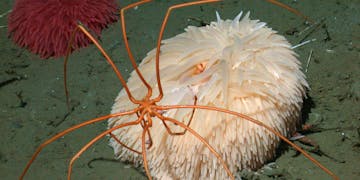Pycnogonids are deep-sea animals related to the spiders we see on land, so they are often called “sea spiders.” They are fairly common in tide pools, but intertidal species are typically small and hard to see. In contrast, deep-sea pycnogonids can have long legs that grow to over 50 centimeters (20 inches) across! At least two species of the Colossendeis group have been observed by MBARI's remotely operated vehicles deep in Monterey Canyon. These spiders are quite mobile and can walk or swim using their eight legs. Pycnogonids are “suctorial” predators—most species feed by sucking the bodily fluids from other marine animals. They feed primarily on anemones, such as the pom-pom anemone, Liponema sp.
Giant sea spider hunches over a pom-pom anemone
Octopus Garden
Aggregations of hundreds of octopuses—most of them brooding females—at the base of Davidson Seamount, just outside of Monterey Bay.
